What bimetallic radiators are better: a brief overview of
We will immediately disappoint the reader: he will not find an unequivocal answer to the question of which bimetallic heating radiators are better in this article. The author does not plan to advertise the products of any manufacturer to the detriment of competitors. Its goal is to objectively illuminate the products on the market from various angles.
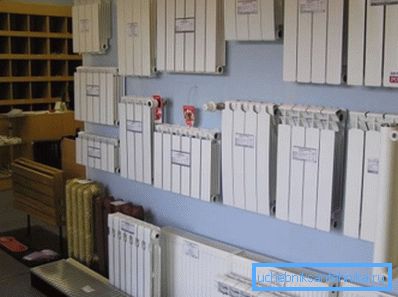
Why bimetal
But in fact, why are bimetal radiators so attractive for customers? Let's start from afar.
To date, the market presents:
- Steel Tubular Batteries (registers). Steel pipe provides exceptional resistance to hydraulic pressure (at least 25 kgf / cm2); However, the low thermal conductivity of the metal makes developed finning meaningless.
- Cast Iron Radiators. Low thermal conductivity is adjacent to moderate mechanical strength: the products are designed for a working pressure of 8-16 kgf / cm2. The brittleness of cast iron is partially compensated by a considerable wall thickness, which ensures a significant heat capacity of radiators.
Useful: this property is very useful in autonomous systems with a solid fuel boiler. Long intervals between kindling are compensated by slow cooling.
- Aluminum batteries - the exact opposite of steel. Moderate resistance to hydraulic pressure (10–16 kgf / cm2) is adjacent to excellent thermal conductivity, which allows decorating sections with a large area of fins. Their small internal volume contributes to rapid heating and rapid cooling.
- Finally, high tensile strength with excellent heat transfer per unit volume combine bimetallic products. Each section is a steel core in an aluminum shell with fins.
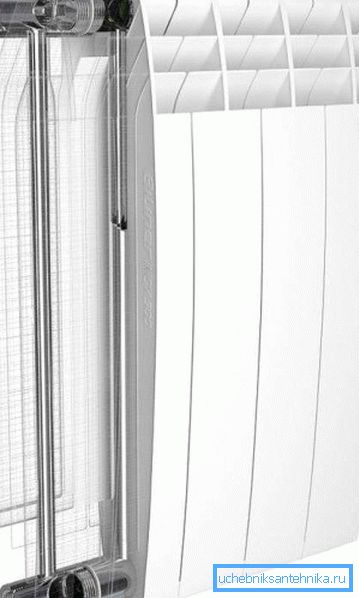
Components of success
By what signs do we have to evaluate bimetallic products? A typical area of application is central heating systems. Despite the completely benign DH parameters in normal mode (temperature 30-95 C, pressure 3-7 atmospheres), force majeure is possible (and it often happens).
Examples?
You are welcome.
- At the peak of frosts in the northern regions, it is sometimes practiced to work at the elevator assembly with the nozzle removed and the suction plugged: not the coolant mixture from both lines, but only water from a direct pipeline enters the bottling. Yes, this way you can warm a freezing house; however, in violation of all the rules, the temperature of the coolant can reach 120-130 degrees.
By the way: this is why in the northern regions it is strongly not recommended to use polymer and metal-polymer pipes for heating. Their working temperature is limited to 90-95 degrees.
- It is worth when you start the reset system of heating to quickly open the house valve - and the pressure in the circuit will increase not gradually, but in steps. At the same time at the flow front, it can reach 20-30 kgf / cm. The phenomenon is called hydraulic shock and is a frequent cause of accidents in the engineering networks.

So, the rating of bimetallic radiators of heating we will have to be based on two indicators:
- Maximum working temperature.
- Maximum working pressure.
As sane people, we’ll add a couple more options to the list.
- The maximum heat transfer of one section will be an undoubted advantage.
We will agree: in order to avoid confusion, we will use for comparison the characteristics of full-sized sections, with a center distance of 500 mm.
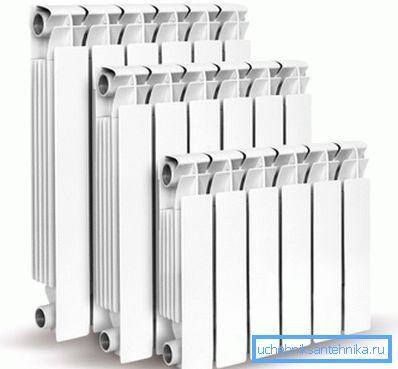
- A reasonable price, of course, can also affect our choices.
So, we proceed to the study of proposals.
Import
Let's start with imported goods on the Russian market.
Global
We have to study a couple of model lines from the Italian company Global: Style Extra and Style Plus.
They have a number of common features:
- Steel cores have both vertical channels of sections and horizontal collectors, which excludes contact of aluminum with water and its corrosion due to electrochemical processes.
- Painting with a durable primer layer is resistant to any cleaning agent.
- Intersection gaskets are made of resistant to deformation during cycles of heating and cooling of paronite (heat-resistant rubber).
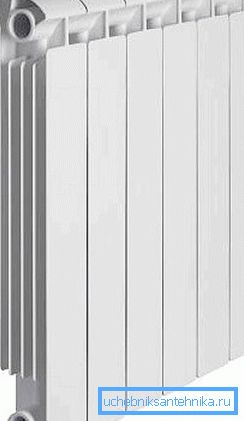
What are the key characteristics? Here are the parameters for Style Extra 500:
| Parameter | Value |
| Working temperature | 110С |
| Operating pressure | 35 kgf / cm2 (with a test pressure of 52.5 kgf / cm2) |
| Heat transfer | 171 watts |
| Section cost | 1030 rubles |
And here is the description of Bimetall Style Plus:
| Parameter | Value |
| Working temperature | 110С |
| Operating pressure | 35 kgf / cm2 (with a test pressure of 52.5 kgf / cm2) |
| Heat transfer | 185 watts |
| Section cost | 1041 rubles |
It is easy to see that the difference between the models is only in a slightly increased heat flow in Style Plus.
Sira
Another famous Italian company is promoting several lines of bimetallic heating devices on the Russian market.
RS Bimetall is a premium product with rounded corners that exclude the possibility of injury.
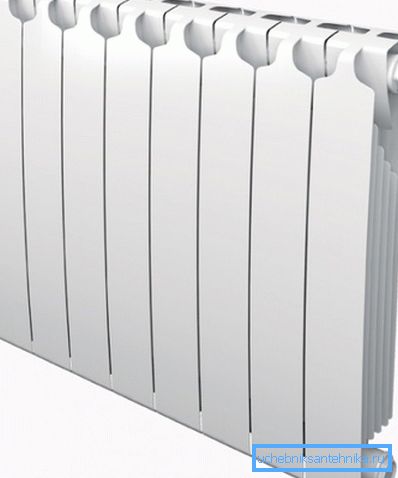
Here are its characteristics:
| Parameter | Value |
| Working temperature | Not specified |
| Operating pressure | 40 kgf / cm2 (with a test pressure of 60 kgf / cm2) |
| Heat transfer | 199 watts |
| Section cost | 750 rubles |
The Ali Metal line is interesting for its special technology of steel-to-aluminum welding, which provides four times more twisting and tensile strength than most products on the market. The core is made of steel with high corrosion resistance.
Other parameters, however, are slightly inferior to the previous line:
| Parameter | Value |
| Working temperature | Not specified |
| Operating pressure | 35 kgf / cm2 |
| Heat transfer | 187 watts |
| Section cost | 690 rubles |
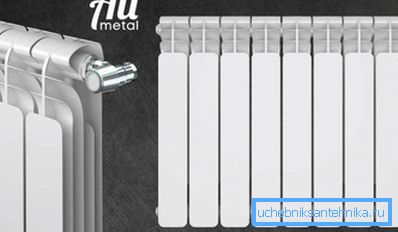
A product called Concurrent is an economical solution that, at least formally, is not inferior to its competitors at a price that is quite democratic against their background.
| Parameter | Value |
| Working temperature | 110С |
| Operating pressure | 35 kgf / cm2 with a test 52.5 kgf / cm2 |
| Heat transfer | 190 watts |
| Section cost | 640 rubles |
An even cheaper line is called Gladiator.
Information about it on the manufacturer's website is very concise:
- Working pressure - up to 35 atmospheres;
- Heat flow - 185 watts per section.
- The cost of one section is 500 rubles.
Tenrad
This company, based in Germany, concentrated production in China, thereby ensuring reasonable cost and the ability to keep reasonable retail prices. Dumping, however, they will not name. In order not to be unfounded, we will invite the reader to study the characteristics of the TENRAD BM line.

| Parameter | Value |
| Working temperature | 120С |
| Operating pressure | 24 kgf / cm2 (tests at 36 atmospheres) |
| Heat transfer | 161 watts |
| Section cost | 812 rubles |
Domestic products
The object of study will serve us several product lines of the domestic company Rifar.
Rifar base
- Working pressure - 20 atmospheres, test - 30.
- Heat transfer section - 204 watts.
- Coolant temperature - up to 120 degrees.
- Retail section cost - 630 rubles.
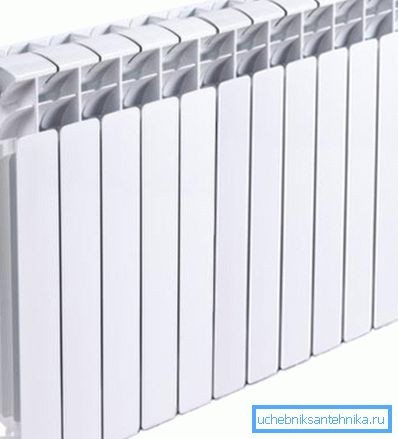
Rifar forza
This line is interesting primarily for a 15-year manufacturer’s warranty.
Other parameters are not particularly stand out from the Base:
- Coolant pressure and hydraulic tests - the same 20/30 atmospheres.
- Operating temperature - up to 120 watts.
- Heat flow - 202 watts per section.
- Price - 630 rubles per section.
Rifar monolit
The product stands out against all competitors.
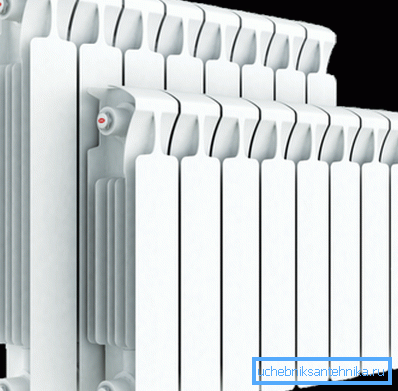
No, not by appearance - it is quite ordinary.
What exactly?
- Manufacturer's warranty in 25 years.
- Lack of nipple connections. Despite the external similarity with sectional radiators, in his case we are dealing with an all-welded core.
- Unusually high (up to 135 degrees) operating temperature.
- Colossal working pressure (100 atmospheres when tested at 150).
Nuance: when installing bimetallic batteries (especially so durable) do it yourself to use only steel pipe wiring. What is the reason for the instruction - it's easy to understand: what's the point in a radiator that can withstand 100 atmospheres, if the pipes break already at 20?

Heat transfer Rifar Monolith on one conditional section of the heating device is quite decent 196 watts; cost of the radiator (in terms of section) - 870 rubles.
Conclusion
The opportunity to choose the best bimetallic radiators of heating on the basis of the information provided is offered to the reader. As always, the attached video contains additional thematic materials. Successes!